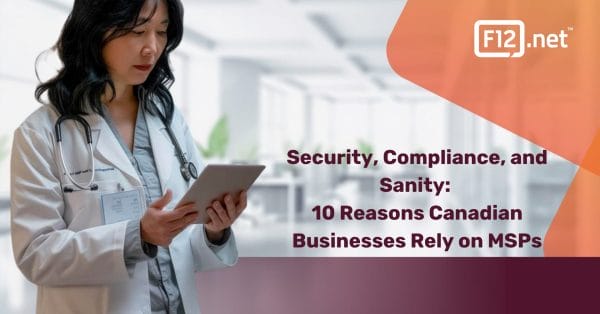Brief: The clock is ticking. On October 14, 2025, Microsoft ends support for Windows 10—leaving businesses exposed to security risk, compliance gaps, and operational headaches. But this isn’t just a technical refresh. It’s a chance to rethink how your organisation plans, deploys, and secures its infrastructure. Here’s what Canadian mid-market businesses should be doing now—and how co-managed IT makes the transition faster, cleaner, and safer.
“Welcome to the party, pal.” — John McClane, Die Hard
For Canadian IT teams facing Windows 10 end-of-life, regulatory pressure, and rising cyber risk—this is the party. You’re already in it. Now the question is: who’s got your back?
Why It’s Not “Just Another Update”
Let’s kill the myth now: migrating to Windows 11 isn’t a long weekend project. With hardware requirements that exclude older machines, software compatibility checks, and operational risk if even one system fails—this is a real transformation.
At F12, we’re helping internal IT teams lead this shift without burning out or falling behind. Co-managed IT gives you added horsepower for project execution, asset management, and governance—so you’re not caught scrambling in Q4 when supply chains jam up and support timelines vanish.
What Mid-Market IT Teams Must Do Now
1. Confirm Device Eligibility
Windows 11 demands newer hardware. At minimum: 11th Gen Intel or Ryzen 5000 series CPUs, 16GB RAM, and SSDs. Devices older than five years? Plan for replacement. Don’t wait to find out your fleet’s not compliant during deployment week.
2. Check App Compatibility
Legacy apps break things. Test every critical system on Windows 11—especially custom or compliance-sensitive software. Involve vendors early. Microsoft 365, Sage, QuickBooks, EMRs—some versions may need patching or upgrades to stay functional.
3. Lock in Hardware Now
Canadian businesses are already facing delays. Expect 2–5 week lead times on compliant devices. As end-of-life approaches, so does the backlog. Smart companies are pre-ordering hardware with service partners like F12, including white-glove setup and secure asset tagging.
4. Treat This Like a Business Project
This isn’t “an IT task.” It’s an enterprise risk. Assign executive sponsorship, involve finance and compliance, and establish clear milestones. Co-managed IT partners like F12 can help project manage, provide capacity, and drive accountability.
5. Validate Your Backups
A backup isn’t useful if it can’t be restored. Before deployment begins, confirm clean restore points across devices—and simulate failure scenarios. Data loss is the hidden risk most internal teams underestimate during OS upgrades.
6. Create a Staged Rollout Plan
Don’t upgrade everything at once. Identify low-risk users or departments for pilot testing. Build feedback loops. Measure performance. Then move into full deployment with change controls and user communication in place.
7. Prep Your People
Most migration failures come down to poor communication. Train employees on what’s changing, what to expect, and how to get help. Equip your helpdesk—internal or co-managed—to handle a spike in tickets for printer drivers, desktop icons, and missing shortcuts.
8. Double-Check Compliance Settings
Upgrades can reset or disable security settings. Post-deployment, confirm your firewall, EDR, encryption, and group policies are intact. F12 includes a compliance re-check as part of every Windows 11 rollout.
9. Don’t Forget the Audit Trail
If you’re regulated (PHIPA, PIPEDA, PCI DSS), ensure the upgrade includes documentation. Asset logs, change records, updated risk registers—all part of staying audit-ready. We build this into our rollout plans so clients don’t scramble during audit season.
10. Decommission Devices Securely
Old laptops and desktops hold sensitive data. Secure wipe, track, and recycle them according to your governance policy. F12 clients receive chain-of-custody documentation, device serial tracking, and eco-friendly disposal support.
Why Fully Managed IT or Co-Managed IT Changes the Game
Even the most capable internal teams can’t be everywhere. Co-managed IT lets you keep control while gaining execution muscle. We don’t just hand you a checklist we show up with the tools, team, and process to get it done. And we build in reporting that makes your IT team look like stars when leadership asks: “Are we ready?”
FAQs: Windows 11 Migration in Canada
- When is Microsoft ending support for Windows 10?
October 14, 2025. After that, you’ll stop receiving security updates—creating immediate risk. - Can I keep using Windows 10 after that?
Technically yes—but it’s strongly discouraged. Unpatched systems become prime targets for malware and ransomware. - What hardware is required for Windows 11?
At minimum: 11th Gen Intel or Ryzen 5000 processor, 16GB RAM, and SSD storage. TPM 2.0 and UEFI are also required. - Will my current software work with Windows 11?
Not always. Many older or custom apps need updates. Test them before rollout—especially anything mission-critical. - How can F12 help with the migration?
We manage the entire process: hardware procurement, compatibility testing, staged deployment, security configuration, compliance documentation, and end-user support—while integrating with your internal IT team.
Windows 10 is sunsetting. The migration clock is ticking. But this isn’t a crisis—it’s an opportunity. With the right partner, this can be a catalyst to modernise your fleet, strengthen compliance, and free up your IT team to focus on what’s next.
Let’s make sure your next OS upgrade isn’t just smooth—but strategic.
Let’s talk. Schedule a migration readiness consult



